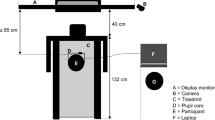Abstract
Self-localization is the behavior of pedestrians when they are disoriented in wayfinding. The widely used AR (augmented reality) navigation technology makes people understanding their location more intuitively. The signals that can be used for self-localization include landmarks, road names, direction guidance, etc., but these elements cannot all be added on a limited size screen. This paper using eye tracking technology to conduct an experiment, aims at exploring the relationship between different augmented information combinations and pedestrian self-localization efficiency and success rate in augmented scenes. Results show that direction guidance is the easiest information to understand, landmark is an important factor in increasing pedestrian safety, and road name has very low help for self-localization and can even increase people’s cognitive burden.
Access this chapter
Tax calculation will be finalised at checkout
Purchases are for personal use only
Similar content being viewed by others
References
Brügger, A., Richter, K.-F., Fabrikant, S.I.: How does navigation system behavior influence human behavior? Cogn. Res. Principles Implications 4(1), 1–22 (2019). https://doi.org/10.1186/s41235-019-0156-5
Ehinger, K.A., Hidalgo-Sotelo, B., Torralba, A., Oliva, A.: Modelling search for people in 900 scenes: a combined source model of eye guidance. Visual Cogn. 17, 945–978 (2009). https://doi.org/10.1080/13506280902834720
Hassan, S.E., Hicks, J.C., Lei, H., Turano, K.A.: What is the minimum field of view required for efficient navigation? Vision. Res. 47, 2115–2123 (2007). https://doi.org/10.1016/j.visres.2007.03.012
Hegarty, M.: Development of a self-report measure of environmental spatial ability. Intelligence. 30, 425–447 (2002). https://doi.org/10.1016/S0160-2896(02)00116-2
Kiefer, P., Giannopoulos, I., Raubal, M.: Where am I? investigating map matching during self-localization with mobile eye tracking in an urban environment. Trans. GIS 18, 660–686 (2014). https://doi.org/10.1111/tgis.12067
Koletsis, E., van Elzakker, C.P.J.M., Kraak, M.-J., Cartwright, W., Arrowsmith, C., Field, K.: An investigation into challenges experienced when route planning, navi-gating and wayfinding. Int. J. Cartography 3, 4–18 (2017). https://doi.org/10.1080/23729333.2017.1300996
May, A.J., Ross, T., Bayer, S.H., Tarkiainen, M.J.: Pedestrian navigation aids: infor-mation requirements and design implications. Pers. Ubiquit. Comput. 7, 331–338 (2003). https://doi.org/10.1007/s00779-003-0248-5
Meilinger, T., Hölscher, C., Büchner, S.J., Brösamle, M.: How Much Information Do You Need? Schematic Maps in Wayfinding and Self Localisation. In: Barkowsky, T., Knauff, M., Ligozat, G., Montello, D.R. (eds.) Spatial Cognition 2006. LNCS (LNAI), vol. 4387, pp. 381–400. Springer, Heidelberg (2007). https://doi.org/10.1007/978-3-540-75666-8_22
Park, S.: Attention scales with object size. Nature Human Behav. 3, 12–13 (2019). https://doi.org/10.1038/s41562-018-0497-y
Tanabe, A., Yoshioka, Y.: Gazing Pattern While Using AR Route-Navigation on Smartphone. In: Ahram, T. (ed.) AHFE 2019. AISC, vol. 973, pp. 325–331. Springer, Cham (2020). https://doi.org/10.1007/978-3-030-20476-1_33
Van Der Lans, R., Pieters, R., Wedel, M.: Eye-movement analysis of search effectiveness. J. Am. Stat. Assoc. 103, 452–461 (2008). https://doi.org/10.1198/016214507000000437
Wang, C., Chen, Y., Zheng, S., Liao, H.: Gender and age differences in using indoor maps for wayfinding in real environments. ISPRS Int. Geo-Inf. 8, 11 (2019). https://doi.org/10.3390/ijgi8010011
Wen, J., Helton, W.S., Billinghurst, M.: A study of user perception, interface performance, and actual usage of mobile pedestrian navigation aides. Proc. Hum. Factors Ergon. Soc. Annu. Meet. 57(1), 1958–1962 (2013). https://doi.org/10.1177/1541931213571437
Zhang, X., Li, Q., Fang, Z., Lu, S., Shaw, S.: An assessment method for landmark recognition time in real scenes. J. Environ. Psychol. 40, 206–217 (2014). https://doi.org/10.1016/j.jenvp.2014.06.008
Acknowledgement
The research was supported in part by the National Natural Science Foundation of China (Grants 41771473, 41231171) and National key R&D plan (Grant 2017YFC1405302).
Author information
Authors and Affiliations
Corresponding authors
Editor information
Editors and Affiliations
Rights and permissions
Copyright information
© 2020 Springer Nature Switzerland AG
About this paper
Cite this paper
Yang, F., Fang, Z., Guan, F. (2020). What Do We Actually Need During Self-localization in an Augmented Environment?. In: Di Martino, S., Fang, Z., Li, KJ. (eds) Web and Wireless Geographical Information Systems. W2GIS 2020. Lecture Notes in Computer Science(), vol 12473. Springer, Cham. https://doi.org/10.1007/978-3-030-60952-8_3
Download citation
DOI: https://doi.org/10.1007/978-3-030-60952-8_3
Published:
Publisher Name: Springer, Cham
Print ISBN: 978-3-030-60951-1
Online ISBN: 978-3-030-60952-8
eBook Packages: Computer ScienceComputer Science (R0)




